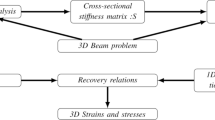Abstract
Of late, metamaterials have been designed such that they possess properties that can switch between positive and negative signs depending on the external environment. This paper draws inspiration from an Islamic geometric design at the Alhambra Palace for designing a metamaterial that exhibits positive coefficients of thermal, pressure, and moisture expansions upon cooling, pressurizing, and drying but manifests negative coefficients of thermal, pressure, and moisture expansions with heating, deceasing pressure, and moistening such that the metamaterial always shrinks with environmental changes with reference from the original state. The metamaterial is constructed by using straight bimaterial strips with alternating orientation that are joined at the rigid hexagonal junction nodes to form equilateral triangular array such that it transforms into the hexachiral honeycomb structure regardless of how the environmental conditions change. Results indicate that every effective in-plane expansion coefficient is almost linearly proportional to its corresponding environmental change. In addition to exhibiting sign-switching expansion coefficients, the metamaterial displays positive Poisson’s ratio in its original state but manifests negative Poisson’s ratio upon environmental change(s).
Graphical abstract
This metacomposite is inspired by an Islamic geometric pattern that manifests expansion coefficients which toggle between positive and negative so as to exhibit persistently negative environmental strain.











Similar content being viewed by others
References
Fan W, Shan C, Guo H, Sang J, Wang R, Zheng R, Sui K, Nie Z (2019) Dual-gradient enabled ultrafast biomimetic snapping of hydrogel materials. Sci Adv 5(4):eaav7174
Xie P, Liu Y, Feng M, Niu M, Liu C, Wu N, Sui K, Patil RR, Pan D, Guo Z, Fan R (2021) Hierarchically porous Co/C nanocomposites for ultralight high-performance microwave absorption. Adv Compos Hybrid Mater 4(1):173–185
Jiang JW, Chang T, Guo, (2016) Tunable negative Poisson’s ratio in hydrogenated graphene. Nanoscale 8(35):15948–15953
Qin R, Zheng J, Zhu W (2017) Sign-tunable Poisson’s ratio in semi-fluorinated graphene. Nanoscale 9(1):128–133
Zeng B, Long M, Dong Y, Xiao J, Zhang S, Yi Y, Gao Y (2019) Stress-sign-tunable Poisson’s ratio in monolayer blue phosphorus oxide. J Phys Condens Matter 31(29):295702
Lim TC (2019) Composite microstructures with Poisson’s ratio sign switching upon stress reversal. Compos Struct 209:34–44
Lim TC (2019) Metamaterials with Poisson’s ratio sign toggling by means of microstructural duality. SN Applied Sciences 1(2):176
Li D, Ma J, Lakes RS (2016) A bi-material structure with Poisson’s ratio tunable from positive to negative via temperature control. Mater Lett 181:285–288
Jopek H, Strek T (2018) Thermoauxetic behavior of composite structures Materials 11(2):294
Lim TC (2019) A class of shape-shifting composite metamaterial honeycomb structures with thermally-adaptive Poisson’s ratio signs. Compos Struct 226:111256
Lim TC (2019) 2D metamaterial with in-plane positive and negative thermal expansion and thermal shearing based on interconnected alternating bimaterials. Mater Res Express 6(11):115804
Gao Q, Chen J, Sun Q, Chang D, Huang Q, Wu H, Sanson A, Milazzo R, Zhu H, Li Q, Liu Z, Deng J, Xing X (2017) Switching between giant positive and negative thermal expansions of a YFe(CN)6-based prussian blue analogue induced by guest species. Angew Chem 56(31):9023–9028
Lim TC (2019) A 2D auxetikos system based on interconnected shurikens. SN Applied Sciences 1(11):1383
Lim TC (2020) Metacomposite with auxetic and in situ sign reversible thermal expansivity upon temperature fluctuation. Compos Commun 19:30–36
Lim TC (2019) A composite metamaterial with sign switchable elastic and hygrothermal properties induced by stress direction and environmental change reversals. Compos Struct 220:185–193
Lim TC (2019) Composite metamaterial with sign-switchable coefficients of hygroscopic, thermal and pressure expansions. Adv Compos Hybrid Mater 2(4):657–669
Rafsanjani A, Pasini D (2016) Multistable compliant auxetic metamaterials inspired by geometric patterns in Islamic arts. Bull Am Phys Soc 61(2):K40.00008
Rafsanjani A, Pasini D (2016) Bistable auxetic mechanical metamaterials inspired by ancient geometric motifs. Extreme Mech Lett 9(2):291–216
Abdullahi Y, Embi MRB (2013) Evolution of Islamic geometric patterns. Front Arch Res 2(2):243–251
Lim TC (2020) Composite metamaterial square grids with sign-flipping expansion coefficients leading to a type of Islamic design. SN Applied Sciences 2(5):918
Lim TC (2020) Metacomposite structure with sign-changing coefficients of hygrothermal expansions inspired by Islamic motif. Compos Struct 251:112660
Lim TC (2021) A perfect 2D auxetic sliding mechanism based on an Islamic geometric pattern. Engineering Research Express 3(1):015025
Medvecky MJ, Ong BC, Rokito AS, Sherman OH (2001) Thermal capsular shrinkage: basic science and clinical applications. Arthroscopy 17(6):624–635
Danoff JR, Karl JW, Birman MV, Rosenwasser MP (2011) The use of thermal shrinkage for scapholunate instability. Hand Clin 27(3):309–317
Wikipedia – Thermal expansion https://en.wikipedia.org/wiki/Thermal_expansion#Coefficient_of_thermal_expansion (accessed January 26th, 2021)
Wikipedia – Young’s modulus https://en.wikipedia.org/wiki/Young%27s_modulus (accessed January 26th, 2021)
Wikipedia – Elastic properties of the elements (data page) https://en.wikipedia.org/wiki/Elastic_properties_of_the_elements_(data_page) (accessed January 26th, 2021)
Adams DF, Monib MM (1980) Moisture expansion and thermal expansion coefficients of a polymer-matrix composite material. In: Lenoe EM, Oplinger DW, Burke JJ (eds) Fibrous Composites in Structural Design. Plenum Press, New York, pp 819–830
Adamson MJ (1980) Thermal expansion and swelling of cured epoxy resin used in graphite/epoxy composite materials. J Mater Sci 15(7):1736–1745
DS Cairns DF Adams 1984 Moisture and thermal expansion properties of unidirectional composite materials and the epoxy matrix GS Springer Eds Environmental Effects on Composite Materials Technomic Publishing Company 2 Lancaster Pennsylvania 300 325
Weitsman YJ (2000) Effects of fluids on polymeric composites – a review. In: Kelly A, Zweben C (eds) Comprehensive Composite Materials, Vol. 2, Elsevier, pp. 369–401
Lim TC (2021) An auxetic system based on interconnected Y-elements inspired by Islamic geometric patterns. Symmetry 13(5):865
Lim TC (2021) An auxetic metamaterial with tunable positive to negative hygrothermal expansion by means of counter-rotating crosses. Phys Status Solidi B 258:2100137
Author information
Authors and Affiliations
Corresponding author
Ethics declarations
Conflict of interest
The author declares no competing interests.
Additional information
Publisher's Note
Springer Nature remains neutral with regard to jurisdictional claims in published maps and institutional affiliations.
Rights and permissions
About this article
Cite this article
Lim, TC. Metamaterial honeycomb with sign-toggling expansion coefficients that manifests an Islamic mosaic pattern at the Alhambra Palace. Adv Compos Hybrid Mater 4, 966–978 (2021). https://doi.org/10.1007/s42114-021-00267-4
Received:
Revised:
Accepted:
Published:
Issue Date:
DOI: https://doi.org/10.1007/s42114-021-00267-4




